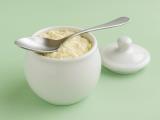While turmeric has numerous positive effects, in recent years the question has arisen: can excessive consumption of this spice harm the kidneys?
The answer is: YES, it can!
Turmeric and Curcumin: What's the Difference?
First, let's clarify the basics. Turmeric is a plant from the ginger family, and its root is what we grind into the familiar yellow powder. It contains a substance called curcumin. This is the component that gives turmeric its power, similar to how vitamin C is in lemon or caffeine is in coffee.
Curcumin acts as a potent antioxidant. This means it helps to neutralize harmful free radicals (small particles that form in the body and can cause cell damage). Additionally, it has anti-inflammatory properties, and since inflammation is often the cause or consequence of many diseases, curcumin has become a star in modern research.
But, as with everything, the saying holds true here too: too much of a good thing can be detrimental.
How Does Turmeric Affect the Kidneys?
The kidneys are organs that filter about 180 liters of fluid per day. This results in 1.5 to 2 liters of urine being produced as waste. Urine contains oxalates, which are natural acids found in many foods (spinach, rhubarb, walnuts... and yes, turmeric is among them).
Excessive oxalates in the body can form crystals that clump together into kidney stones. These painful formations often lead to hospital visits. In the United States alone, there were over 500,000 cases of kidney stones recorded in 2023, meaning roughly one in ten adults will experience this issue in their lifetime.
The American Kidney Foundation warns that excessive consumption of curcumin can increase the amount of oxalates in the urine and, therefore, the risk of kidney stone formation. This doesn't mean that turmeric is inherently bad, but it should be used in moderation.
How Much Turmeric is Safe to Consume?
If you use turmeric as a spice, for example, adding it to rice, soup, or sauce, it is entirely safe. Typical culinary doses range from 1 to 2 grams per day (roughly half to one teaspoon). This amount provides benefits without significant risks.
The problem arises when people start taking curcumin supplements. These often contain doses of 500 to 1000 milligrams of pure curcumin per capsule, which is much higher than what you would typically consume through food. While such a dose may be beneficial for certain conditions (such as arthritis), it can pose an additional burden on the kidneys in sensitive individuals.
American nutritionist Kejal Shah, who studied in India and now lives and works in Los Angeles, warns that supplements are where we must be most cautious.
What Do Studies Say?
While there aren't many studies on the impact of turmeric on the kidneys, some important data is available:
- Animal studies (Pharmaceutics journal, 2021) have shown that very high doses of curcumin can cause kidney damage.
- Human studies (Molecules journal, 2022) have found that curcumin plays a protective role in chronic diseases such as diabetes and high blood pressure – two major causes of chronic kidney disease.
In the years 2020-2024, several clinical studies conducted in India and the US found that moderate doses of turmeric help reduce inflammation and improve the well-being of patients with chronic conditions, but they cautioned about the increased risk of stone formation in those who already had issues.
This means that turmeric is not a miraculous cure, but it is not toxic either. It is the doses that determine whether it will be beneficial or harmful.
Turmeric in Practice
During the COVID-19 pandemic, many turned to homemade turmeric, ginger, and honey drinks. For example, in India, the consumption of turmeric increased by 15% in 2020 compared to the previous year, as people believed it boosted immunity. Similarly, sales of turmeric dietary supplements rose in Europe. A 2021 study revealed a 12% increase in the turmeric supplement market in one year.
Reports from US hospitals in 2024 showed an increase in cases of kidney stones in people who regularly took high doses of curcumin supplements. Doctors warned that this often involved individuals who sought to expedite recovery by taking double or triple the recommended amount.
When Should You Be Cautious?
If you are among those who already have kidney issues or have had kidney stones, it's best not to overdo it with turmeric. Also, if you are taking blood thinners or diabetes medications, be cautious as turmeric can affect their efficacy...
Additionally, those on low-oxalate diets should be cautious. If your doctor has advised you to avoid foods high in oxalates, then use turmeric in small amounts.
How Can Turmeric be Used Safely and Effectively?
The best solution is simple: use turmeric as a spice, not as a medicine. Add it to dishes, soups, stews, or smoothies. If you want its benefits to be better absorbed, combine it with black pepper. Pepper contains piperine, which can increase curcumin absorption in the body by up to 20 times.
For those who enjoy homemade remedies, golden milk (warm milk with turmeric, honey, and a pinch of pepper) is one of the oldest traditional uses of turmeric. This beverage has been used in India for centuries to calm the body and aid with colds.
An Affordable Homemade Solution for Healthy Kidneys
If you are concerned about your kidneys, the first thing you can do is drink enough water. At least 2 liters per day, unless there are other restrictions. This is the cheapest and most effective way to prevent stones. Additionally, limit consumption of salty foods and maintain a balanced diet.
Turmeric should remain a spice, something that adds color, flavor, and medicinal properties to your dishes. However, if considering supplements, consult a doctor first, especially if you have any kidney issues.
Conclusion
Turmeric is indeed a golden spice, but it is not a magic wand. It can help with inflammation, digestion, and overall well-being, but excessive amounts can burden the kidneys. As with everything in life, moderation is key. If used in small culinary amounts, you will enjoy all its benefits without significant risks. However, if opting for capsules, be cautious, as the difference between a therapeutic and harmful dose can often be found in just one capsule.









 Would you like to be informed about news on the website?
Would you like to be informed about news on the website?

